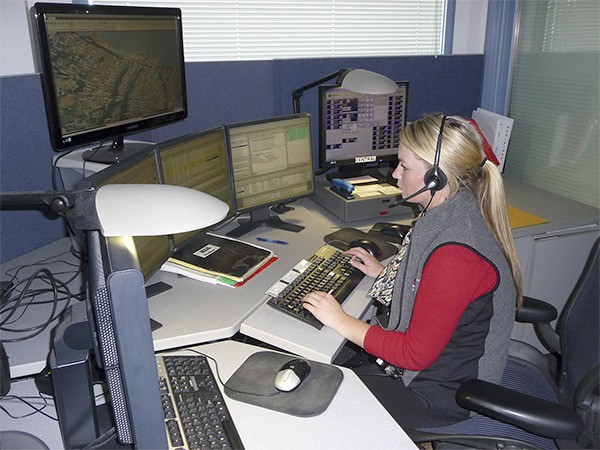Since its inception in 1968, the 9-1-1 emergency dispatching system has saved countless lives but the system isn’t perfect in two crucial ways.
They both have to do with what the public’s perception of what an emergency is and isn’t and the significant problem of 9-1-1 hangups. In 2013, of Clallam County’s 35,088 calls to 9-1-1, 5,285 were hangups or abandoned calls.
According to Deb Homan, one of three working supervisors at PenCom, the county’s main dispatching center, 9-1-1 hangups definitely are a problem with each averaging about three minutes to resolve. In 2013, that amounted to 264.25 hours when dispatchers’ time and attention were diverted from true emergencies.
The definition of a 9-1-1 hangup Homan said, “is any call we receive in the center that we’re not able to establish contact with someone or that’s abandoned at any point, even before the dispatcher answers the phone.”
She explained that a hangup will appear as a red light on a computer as an incoming call. Per PenCom’s policy, every single call requires investigation, a call back and notification to law enforcement. Based on what the dispatcher hears in the background and the phone number’s history, the officer has the discretion of rolling on a hangup call, expending more resources.
One-button autodialing for 9-1-1 on landlines is a problem but the biggest culprit is that feature on cell phones. In a two-week period from Feb. 23-March 8, there were 104 9-1-1 hangups from active cell phones, 51 from wireless devices with no service (expired phones) and 27 from landlines.
“We try to educate the public to please lock their phone, remove the battery or disable the autodial feature,” said Homan.
The process of unraveling the why and who called 9-1-1 is easier on a landline because the system brings up the resident’s name, address and phone number. With a cell phone, it only gives the phone number and the nearest tower location or a triangulation of the nearest three towers.
Also with landlines and cell phones, the dispatcher can see a history of calls dating back as far as 2000. That’s especially important in past domestic violence cases. Dispatchers will ask if the person can speak freely.
“We have to remember that this call may be the start of a history,” Homan said. “I’ve seen instances of that when people say they are fine, but we send an officer there and sure enough it’s a domestic.”
Homan explained the process of tracking down hangup or abandoned calls.
“A call comes in and it’s entered into CAD (computer aided dispatch). We attempt to call back and check the history on the number. On landlines and cell phones with an open line, we’re going to do a TTY challenge in case the person is hearing impaired. We notify the proper agency and add information from the call back and then update the agency. If we get an answering machine, we notify officers or deputies of the situation — our policy is to notify officers of the history and what we heard. It’s a time consuming process,” Homan said.
Although most people are cooperative in answering a few questions on a call back, there are others that are uncooperative about giving information to dispatchers and hang up again.
“People need to remember that 9-1-1 is for an immediate threat to property or life. If not, they need to call the business line: Sequim Police, 683-7227; Port Angeles Police, 452-4545; or Clallam County Sheriff, 417-2459,” Homan said. “When the power goes out, don’t call 9-1-1, call the power company unless the fire department or law enforcement is required because of an unsafe situation.”
Homan is part of the state’s public education program on the use and abuse of 9-1-1.
“The main thing is do not hang up, even if it’s a mistake. Stay on the line and cooperate with the questions. Accuracy, brevity and clarity are the ABCs that we live by and strive for. We’re masters at multitasking and we have to juggle a lot,” Homan said. “We’re here 24/7 if you truly need our services — that’s what we’re here for.”
PenCom, which is housed in the Port Angeles Police Department, has 15 dispatchers and three dispatcher supervisors. It dispatches for 17 different agencies and is the primary answering point for Clallam County 9-1-1. There always are three dispatchers on duty and they work 12-hour shifts. Trainees spend four months in the classroom and at the console with an experienced dispatcher, plus attend state training in medical protocols.
“What’s frustrating for me is when a caller needs help and can’t speak freely or doesn’t know where he or she is at because you want to help them and you can’t until you get information from them,” Homan said.
“It’s so important to pay attention to your surroundings and landmarks so there’s not a delay in service. We ask questions to update medics and officers, not because we’re nosy. For all of us in here it’s our nature to want to help people. It gets in your blood. After doing this I can’t imagine going back to a regular job. It’s a very rewarding job because I can say, ‘I saved a life today.’”
Homan demurred when asked on a scale of 1-10 how big of a problem 9-1-1 hangups are, but she did say, “They can tie up resources and interfere with true emergencies. They’re resource draining. About 64 percent of our calls are from cell phones and deactivated cell phones are really a problem. We do strive to provide excellent customer service to all the agencies we serve and our callers 24/7.”



